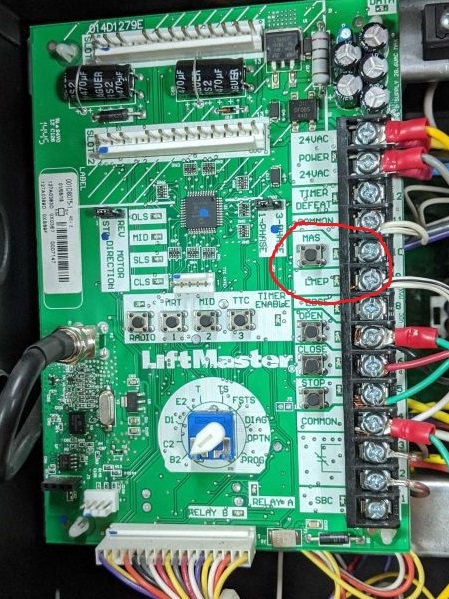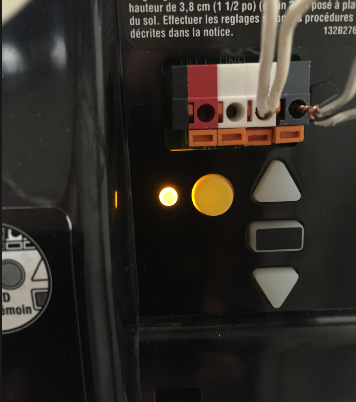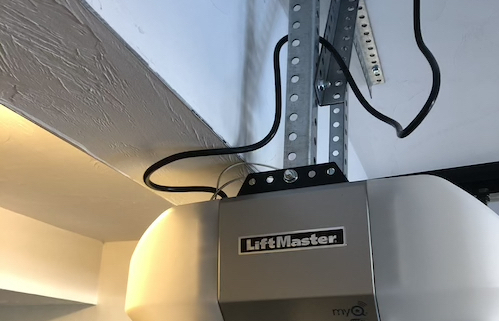For Liftmaster commercial garage door opener troubleshooting, first check the power supply and remote control batteries. Next, inspect sensor alignment and motor functionality.
Proper maintenance can prevent future issues, ensuring smooth operation and safety. Regular inspection and troubleshooting can help identify and address potential problems before they escalate, saving time and money in the long run. By addressing issues promptly and following manufacturer guidelines, you can prolong the lifespan of your Liftmaster commercial garage door opener.
Remember, safety is paramount when dealing with garage door opener troubleshooting, so always prioritize caution and follow proper procedures to avoid accidents.

Credit: ddmgaragedoors.com
Identifying Common Liftmaster Issues
The door won’t Open Or Close
Check for obstructions blocking the door path.
Unusual Noises During Operation
Inspect for loose hardware or worn-out parts.
Remote Control Malfunctions
Replace remote batteries and reprogram if needed.

Credit: www.garaga.com
Quick Fixes For Non-responsive Garage Doors
When your commercial garage door opener stops responding, it can disrupt the flow of business operations. Fortunately, there are several quick fixes you can try to troubleshoot a non-responsive Liftmaster commercial garage door opener. By addressing common issues such as resetting the system, checking the power supply and connections, and adjusting the limits and force settings, you can potentially resolve the problem and get your garage door opener back in working condition.
Resetting The Liftmaster System
If your Liftmaster commercial garage door opener is not responding, a simple reset may solve the issue. To reset the system, locate the reset button on the opener and press it for a few seconds. This action can often restore the functionality of the opener, allowing it to respond to commands effectively.
Checking Power Supply And Connections
Ensuring that the garage door opener has a reliable power supply is crucial for its proper functioning. Check the power source and connections to identify any issues such as loose or damaged wiring. Additionally, inspect the circuit breaker or fuse to confirm that the power supply is uninterrupted and stable.
Adjusting The Limits And Force Settings
Proper adjustment of the limits and force settings on the commercial garage door opener is essential for smooth operation. Use the manufacturer’s instructions to locate and adjust these settings as needed. Incorrect settings can cause the door to become unresponsive or operate irregularly, so ensuring the settings are accurate is crucial for optimal performance.
Resolving Remote Control Problems
If you are encountering issues with your Liftmaster commercial garage door opener remote control, follow these steps to troubleshoot the problem effectively.
Replacing The Battery
Ensure the remote control is not working due to a dead battery.
- Locate the battery compartment on the remote.
- Replace the old battery with a new one.
Reprogramming The Remote
If replacing the battery does not resolve the issue, try reprogramming the remote.
- Access the garage door opener motor unit.
- Press the learn button and follow the instructions.
Checking For Interference
If reprogramming does not work, check for possible interference.
- Remove any nearby sources of interference.
- Test the remote in different locations.
Addressing Noise And Vibration Issues
When it comes to addressing noise and vibration issues with your Liftmaster commercial garage door opener, it’s important to troubleshoot the potential causes and take proactive steps to resolve them. By identifying and addressing the sources of noise and vibration, you can ensure that your garage door operates smoothly and quietly, minimizing disruptions and potential damage.
Lubricating Moving Parts
Regular lubrication of the moving parts is essential to minimize noise and vibration. Using a high-quality silicone-based lubricant on the rollers, hinges, and bearings can significantly reduce friction and noise. It’s crucial to avoid using WD-40 or similar products, as they can attract dirt and debris, leading to further issues.
Tightening Loose Components
If you notice excessive noise or vibration, check for loose components such as nuts, bolts, and screws. Use a wrench or screwdriver to tighten any loose fasteners throughout the garage door opener system. This simple step can effectively reduce rattling and shaking, promoting smoother operation.
Inspecting Rollers And Tracks
Regular inspection of the rollers and tracks is vital to identify wear and tear that may contribute to noise and vibration. Look for worn or misaligned rollers and ensure that the tracks are clean and free from debris. Replace any damaged rollers and clean the tracks to maintain optimal performance.
Handling Error Codes And Warnings
When it comes to operating a commercial garage, encountering error codes and warnings is a common occurrence. Understanding how to handle these issues is crucial for ensuring the smooth functioning of your Liftmaster Commercial Garage Door Opener. Let’s delve into the essential steps for handling error codes and warnings.
Decoding The Blinking LED Lights
If you notice the LED lights on your Liftmaster Commercial Garage Door Opener blinking, it’s essential to decode the patterns to identify the specific error code. Refer to the manufacturer’s manual to understand the meaning of each blinking sequence. Once you’ve identified the code, you can take appropriate action to resolve the issue.
Resetting After Power Outages
Power outages can sometimes disrupt the functioning of your garage door opener, leading to error codes or warnings. To reset the system after a power outage, locate the reset button on the opener and follow the manufacturer’s instructions for the reset procedure. This can help clear any temporary errors caused by power fluctuations.
Troubleshooting Sensor Alarms
When sensor alarms are triggered, it can indicate potential safety hazards or obstructions in the door’s path. Begin by inspecting the sensor alignment and cleanliness. Ensure that the sensors are unobstructed and properly aligned. If the issue persists, refer to the troubleshooting section of the manual for further guidance on addressing sensor alarms.
Maintaining Your Liftmaster Garage Door
Regular maintenance is key to ensuring your Liftmaster commercial garage door opener operates smoothly. By following a consistent cleaning schedule, making seasonal adjustments, and knowing when to seek professional help, you can keep your garage door in top condition.
Regular Cleaning Schedule
- Wipe down the garage door tracks with a clean, damp cloth to remove dirt and debris.
- Inspect the rollers for any signs of wear and tear and lubricate them with garage door lubricant.
- Clean the photo-eye sensors to ensure they are free from dust and debris, preventing any obstructions.
Seasonal Adjustments
- Check the weather stripping around the garage door and replace any damaged sections.
- Adjust the garage door opener force settings according to temperature changes to prevent strain on the motor.
- Tighten any loose hardware, such as bolts, nuts, and screws, to maintain the door’s stability.
When To Seek Professional Help
If you notice unusual sounds during operation, inconsistent movement, or malfunctioning safety features, it’s time to call a professional. Attempting repairs without the necessary expertise can lead to further damage and safety risks.
Upgrading Your Liftmaster Setup
When it comes to upgrading your Liftmaster setup, there are several options available to enhance the performance and functionality of your commercial garage door opener. Whether you’re looking to integrate smart home technology, replace older models, or enhance security features, these upgrades can bring added convenience, efficiency, and peace of mind to your business.
Integrating Smart Home Technology
With the rapid advancement of smart home technology, integrating your Liftmaster commercial garage door opener with these systems can bring a new level of convenience and control. By connecting your opener to a smart home hub or app, you can remotely monitor and operate the door, receive real-time alerts, and even integrate it with other smart devices for seamless automation.
Replacing Older Models
If you have an older Liftmaster commercial garage door opener, upgrading to a newer model can provide improved performance, reliability, and safety features. Newer openers often come equipped with advanced technology, quieter operations, and enhanced security measures to better protect your business assets.
Enhancing Security Features
Enhancing the security features of your Liftmaster setup is crucial for safeguarding your business premises. Upgrading to a model with advanced security technology such as rolling code encryption, motion detection lights, or integrated camera systems can provide added peace of mind and protection against unauthorized access or intrusions.

Credit: christieoverheaddoor.com
Diy Tips For Liftmaster Owners
Essential Tools And Supplies
Before troubleshooting, gather necessary tools and supplies to fix the issue efficiently.
Safety Precautions
Protect yourself by wearing safety goggles and gloves while working on the garage door opener.
Learning From Common Mistakes
Identify common problems, like sensor misalignment or worn-out cables, to avoid future issues.
Frequently Asked Questions
How To Reset A Commercial Liftmaster Garage Door Opener?
To reset a commercial Liftmaster garage door opener, locate the “Learn” button on the opener. Press and hold it until the light blinks. Then, press the “Learn” button again and reprogram the remote. Test the remote to ensure the reset was successful.
Why is my commercial garage door opener not working?
If your commercial garage door opener is not working, it could be due to several reasons, such as power outages, remote control malfunctions, sensor obstructions, or broken springs. Check for these issues and replace or repair them as needed. Contact a professional if you cannot identify the problem or fix it yourself.
Why is my Liftmaster garage door opener not responding?
Your Liftmaster garage door opener may not respond due to remote battery issues or sensor misalignment. Check and replace batteries, realign sensors, and ensure the opener is receiving power.
Why is my commercial garage door not closing all the way?
Your commercial garage door may not be closing due to a sensor misalignment or an obstruction in the door’s path. Check sensors and clear any obstacles.
How Can I Troubleshoot A Liftmaster Commercial Garage Door Opener That Won’t Open or Close?
To troubleshoot a Liftmaster commercial garage door opener that won’t open or close, check for any obstructions in the door’s path and ensure that the photo-eye sensors are properly aligned and free from debris.
Conclusion
Troubleshooting your Liftmaster commercial garage door opener can be a simple process if you follow the right steps. By identifying the problem and carrying out the necessary repairs, you can get your garage door opener up and running again in no time.
Remember to always refer to your manual and seek professional assistance if necessary. With these tips, you can keep your garage door opener working efficiently for years to come.
